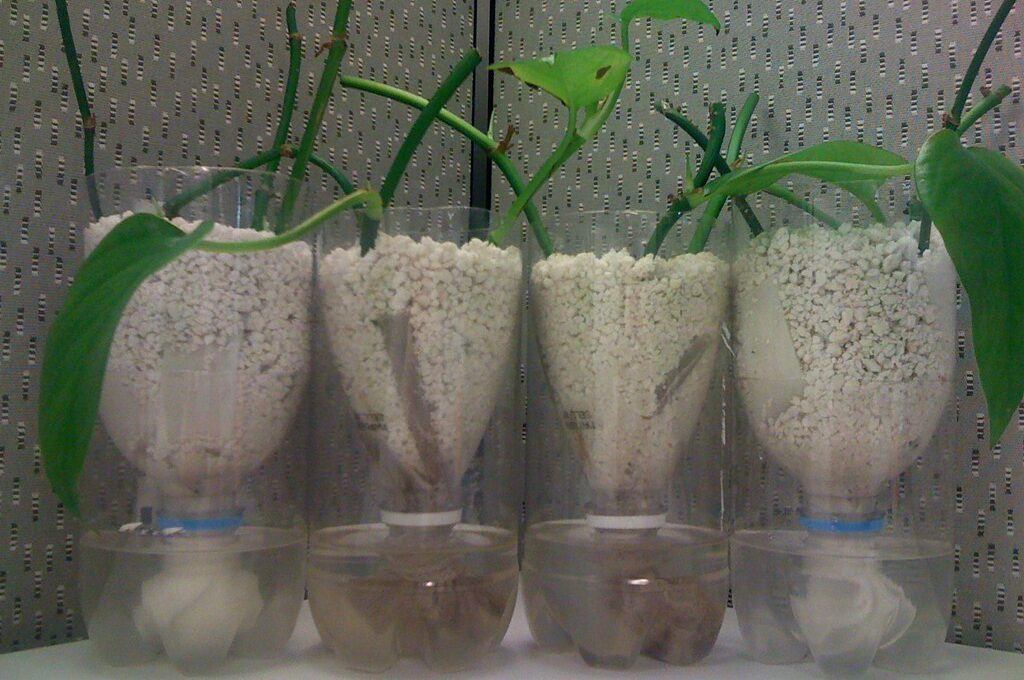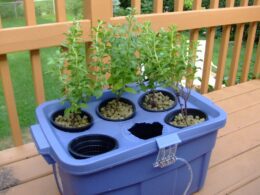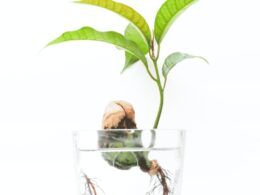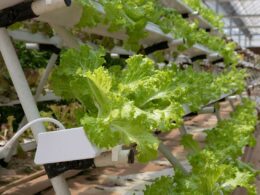Are you looking to grow your own tomatoes but don’t have the space for a traditional garden? Look no further than hydroponics! Hydroponics is a method of growing plants without soil, using nutrient-rich water instead.
And yes, you can certainly grow tomatoes hydroponically! Hydroponics offers a number of benefits for home gardeners, including faster growth, higher yields, and the ability to control the environment in which your plants grow.
Plus, with no soil to worry about, you can avoid many of the pests and diseases that can plague traditional gardens.
In this article, we’ll walk you through everything you need to know to successfully grow your own hydroponic tomatoes, from choosing the right variety to setting up your system and caring for your plants. So let’s get started!
Understanding Hydroponics
By diving into the world of hydroponics, you’ll discover the innovative and efficient methods used to cultivate a wide range of plants without soil. Hydroponic techniques involve growing plants in a nutrient-rich solution rather than traditional soil. This approach offers numerous benefits, including better plant growth and yield, reduced water use, and fewer pest problems.
One of the most significant advantages of hydroponics is that it allows for precise control over growing conditions. With hydroponic systems, you can adjust lighting, temperature, and nutrient levels to meet the unique needs of each plant. This level of control results in faster growth, higher yields, and more consistent quality across all plants.
In addition to better plant growth, hydroponics also offers environmental benefits. By eliminating the need for soil, hydroponic systems use less water and produce less waste. This makes them an ideal choice for urban gardeners or those looking to reduce their environmental footprint.
With the benefits of hydroponics, it’s easy to see why so many gardeners are turning to this innovative growing technique.
Choosing the Right Tomato Variety
If you’re considering growing tomatoes hydroponically, you’ll want to choose the right variety for your setup.
One key factor to consider is whether you want determinate or indeterminate tomatoes. Determinate varieties tend to be more compact and bushy, while indeterminate varieties continue to grow and produce fruit throughout the season.
Additionally, some tomato varieties are better suited for hydroponic gardening than others, so it’s important to do your research and select the best option for your needs.
Determinate vs Indeterminate Tomatoes
When choosing tomato plants for your hydroponic garden, it’s important to understand the difference between determinate and indeterminate varieties. Determinate tomatoes are compact and bushy, with a predetermined height and fruiting period. They are ideal for small spaces and require little to no pruning.
On the other hand, indeterminate tomatoes are tall and vine-like, with continuous growth and fruiting throughout the season. They require regular pruning to control their size and promote fruit production.
If you have limited space in your hydroponic garden, determinate tomatoes may be the better choice for you. They’re easier to manage and require less maintenance than indeterminate varieties. However, if you have ample space and are willing to put in the effort to prune and train your plants, indeterminate tomatoes can provide a bountiful harvest throughout the growing season.
Ultimately, the choice between determinate and indeterminate tomatoes comes down to personal preference and the specific needs of your hydroponic garden.
Best Tomato Varieties for Hydroponic Gardening
Looking to add some variety to your hydroponic garden? Check out these top tomato varieties that thrive in a soil-free environment!
When it comes to growing hydroponic tomatoes, choosing the right variety is key. Some of the best tomato varieties for hydroponic gardening include Ace, Beefsteak, Cherry, and Roma. These varieties are known for their high yield and exceptional taste.
To maximize your hydroponic tomato harvest, it’s important to use proper growing techniques and pest management. Hydroponic tomatoes require a steady supply of nutrients and water, so it’s important to monitor your system daily and adjust as needed.
Additionally, pests can still be a problem in hydroponic gardens, so be sure to regularly inspect your plants and use organic pest management methods such as neem oil or insecticidal soap.
With the right variety and proper care, you can enjoy a bountiful harvest of delicious hydroponic tomatoes!
Setting Up Your Hydroponic System
When setting up your hydroponic system, there are three key points to consider:
- Choosing the right container: Make sure it’s large enough to hold your plants and their roots comfortably, and that it allows for proper drainage.
- Selecting the right nutrient solution: This will depend on the specific needs of the plants you plan to grow.
- Addressing lighting and temperature requirements: Pay close attention to these factors to ensure optimal growth.
You’ll want to make sure that each of these three aspects is addressed properly in order to have a successful hydroponic system.
Choosing the Right Container
Pick the perfect vessel to hold your tomato plants and watch them flourish in their nutrient-rich environment. When choosing the right container for your hydroponic tomato plants, there are a few things to keep in mind. Here are four important considerations to make:
- Container materials: The material of the container you choose can impact the overall growth and health of your plants. Plastic containers are affordable and lightweight, but they can also leach harmful chemicals into the water. Glass containers are a better option, but they can be heavy and fragile. Ceramic containers are a great choice as they’re sturdy, inert, and can add aesthetic value to your hydroponic garden.
- Size considerations: The size of your container will determine how many plants you can grow in it. It’s important to choose a container that is big enough to provide enough space and nutrients for your plants to thrive. A good rule of thumb is to have at least 5 gallons of water per plant to ensure proper hydration and nutrition.
- Drainage: Your container should have proper drainage to prevent water from pooling and causing root rot. Choose a container with drainage holes at the bottom or drill your own if necessary.
- Accessibility: Consider how easy it’ll be to access your plants for maintenance and harvesting. A container that’s too tall or narrow may make it difficult to tend to your plants and harvest ripe tomatoes.
By keeping these factors in mind when choosing your container, you can set your hydroponic tomato plants up for success and ensure a bountiful harvest.
Selecting the Right Nutrient Solution
Now that you’ve chosen the perfect container for your hydroponic tomatoes, the next step is to select the right nutrient solution. This is an important aspect of hydroponic gardening because the plants won’t be getting any nutrients from soil. Instead, you’ll be adding them to the water directly.
Maintaining pH levels is crucial when it comes to selecting a nutrient solution. Tomatoes prefer a slightly acidic environment with a pH range of 5.5-6.5. It’s important to check the pH levels regularly and adjust accordingly to prevent nutrient deficiencies that can stunt the growth of your plants.
Nutrient deficiencies can also occur if the solution is not well-balanced, so it’s important to choose a solution that contains all the necessary nutrients for proper growth. By selecting the right nutrient solution and maintaining ideal pH levels, you can ensure that your hydroponic tomatoes grow healthy and strong.
Lighting and Temperature Requirements
Achieving optimal lighting and temperature conditions is crucial for the success of your hydroponic tomato garden, as it directly impacts the growth and yield of your plants. The right lighting is essential for photosynthesis, which is the process by which plants produce energy.
Tomatoes typically require at least 6 hours of direct sunlight per day, but if you’re growing hydroponically, you’ll need to provide artificial lighting to ensure your plants receive enough light. LED grow lights are a popular choice for hydroponic gardens because they’re energy-efficient, long-lasting, and can be customized to provide the right spectrum of light for your plants.
In addition to lighting, you must also consider the temperature requirements for your plants. Tomatoes prefer temperatures between 70-80°F during the day and 60-65°F at night. Maintaining consistent temperatures is crucial for maximizing yield and preventing stress on your plants.
You can use a thermometer to monitor the temperature in your grow room and make adjustments as needed. A fan can help circulate the air and regulate the temperature, but be careful not to create too much airflow, which can damage your plants.
By providing optimal growing conditions, you can ensure a successful hydroponic tomato garden with a bountiful harvest.
Planting and Caring for Your Tomato Plants
Taking care of your tomato plants is crucial for a bountiful harvest. When planting your tomato seeds, make sure to use a growing medium that’s appropriate for hydroponics. This is because the correct medium will provide your plants with the necessary nutrients. Most hydroponic growers use rockwool cubes or coconut coir as their growing medium.
Once your plants have sprouted, it’s important to provide them with the right amount of nutrients. This means keeping a close eye on your nutrient solution, as well as pH and conductivity levels. You’ll also want to prune your tomato plants regularly to remove any dead or dying leaves. Tomato pruning not only helps to keep your plants healthy, but it also encourages the growth of new fruit.
Pest management is another important aspect of caring for your tomato plants. Keep a lookout for common pests such as aphids, spider mites, and whiteflies. You can use natural predators such as ladybugs or lacewings to control pest populations, or you can use organic pest control products.
With proper care and attention, your hydroponic tomato plants will thrive and produce an abundant harvest.
Harvesting and Enjoying Your Hydroponic Tomatoes
Get ready to savor the juicy and flavorful fruits of your labor with these simple tips for harvesting and enjoying your hydroponic tomato harvest.
First, before harvesting your tomatoes, make sure they’re fully ripe. You can determine this by looking for a deep red color and a slight give when gently squeezed. If some of your tomatoes aren’t quite ripe yet, leave them on the vine a bit longer to fully develop their flavor.
When it’s time to harvest, gently twist and pull the tomato from the vine. Be careful not to damage the vine or any other tomatoes still on the plant.
Once you’ve harvested all of your ripe tomatoes, give them a gentle wash to remove any dirt or debris.
Now it’s time to enjoy your harvest! There are countless tomato recipes to choose from, but one classic favorite is a simple Caprese salad. Slice your hydroponic tomatoes, add fresh mozzarella, basil, and a drizzle of balsamic vinegar and olive oil.
Another tasty option is homemade tomato sauce, perfect for topping pasta or pizza.
Whatever recipe you choose, savor every bite of your delicious hydroponic tomatoes!
Frequently Asked Questions
Can hydroponic tomatoes taste as good as traditionally grown tomatoes?
If you’re wondering about the flavor comparison and nutrient content of hydroponic tomatoes compared to traditional ones, you’ll be pleased to know that recent studies have shown that there is little difference in taste and nutritional value between the two.
In fact, hydroponic tomatoes have been found to have higher levels of certain nutrients due to the precise control over the growing environment. This means that you can enjoy the same great taste and health benefits from hydroponic tomatoes as you would from traditionally grown ones.
So, whether you’re looking to try a new method of growing your tomatoes or simply interested in exploring the differences, hydroponic tomatoes are definitely worth considering.
How often do hydroponic tomato plants need to be watered?
Hydroponic tomato plants have specific watering needs that are crucial for their growth and development. In general, they need to be watered more frequently than traditional tomato plants, usually once or twice a day.
However, the exact watering frequency depends on several factors such as the size of the plant, the environment, and the stage of growth. It’s essential to monitor the plants closely and adjust the watering schedule accordingly.
Additionally, hydroponic tomato plants require specific nutrient requirements, which must be added to the water regularly. By providing adequate water and nutrients, you can ensure that your hydroponic tomato plants thrive and produce delicious, healthy fruits.
Is it more expensive to grow tomatoes hydroponically than traditionally?
When it comes to growing tomatoes, hydroponics is a method that can yield impressive results. However, many people wonder if it’s worth the extra cost compared to traditional methods.
Cost comparison shows that hydroponic systems can be more expensive to set up initially, but they often lead to higher yields and faster growth rates. When using hydroponics, you have more control over the growing environment, which can help reduce the risk of crop failure.
A yield analysis can help you determine if the increased cost of hydroponic growing is worth it for your particular situation. Overall, while hydroponic tomato growing may come with a higher price tag, the potential for increased yield and reduced risk may make it a worthwhile investment.
Can hydroponic tomato plants be grown indoors?
Growing hydroponic tomato plants indoors is not only possible, but it can also be a great way to produce fresh, tasty tomatoes year-round. With the right indoor lighting and nutrient solutions, you can create an environment that is perfect for your tomato plants.
The beauty of hydroponic growing is that you have complete control over the nutrients your plants receive, which can lead to healthier, more vibrant plants that produce high yields.
When growing hydroponic tomatoes indoors, be sure to choose a suitable space and lighting system that provides the right amount of light for your plants. With a little bit of effort and attention, you can enjoy delicious, homegrown tomatoes no matter what the weather is like outside.
What types of pests and diseases are common in hydroponic tomato plants?
Preventing and treating pests and nutrient deficiencies are important aspects of hydroponic tomato plant care. Common pests in hydroponic systems include spider mites, aphids, and whiteflies. To prevent these pests, it’s important to regularly inspect plants and remove any affected leaves or plants. Biological controls, such as ladybugs or predatory mites, can also be introduced to help control pests.
Nutrient deficiencies can also occur in hydroponic systems, which can lead to stunted growth or yellowing leaves. Regularly monitoring nutrient levels and adjusting the nutrient solution can help prevent deficiencies. If a deficiency does occur, it’s important to identify the specific nutrient needed and adjust the solution accordingly.
By taking preventative measures and addressing issues promptly, you can ensure healthy and thriving hydroponic tomato plants.
Conclusion
Congratulations! You’re now ready to start growing your own hydroponic tomatoes.
By understanding the basics of hydroponics, choosing the right variety of tomato, setting up your hydroponic system, and caring for your plants, you can enjoy fresh and delicious tomatoes all year round.
Remember to keep an eye on your plants and make adjustments as needed. Monitor the pH and nutrient levels of your water regularly and provide adequate light and air circulation.
With patience and dedication, you’ll soon be harvesting your very own hydroponic tomatoes. Enjoy the fruits of your labor and share your success with others!









